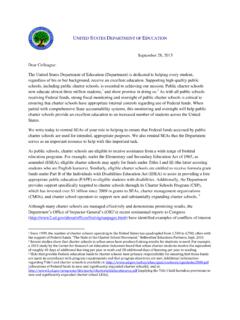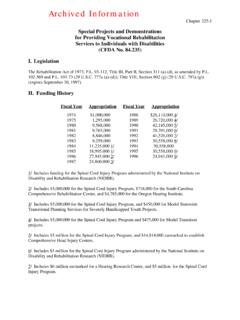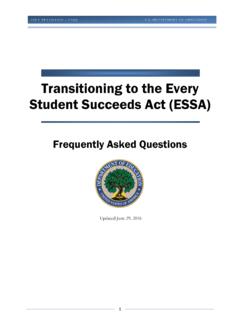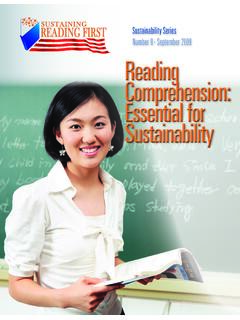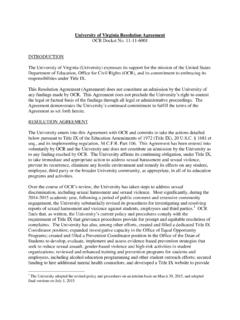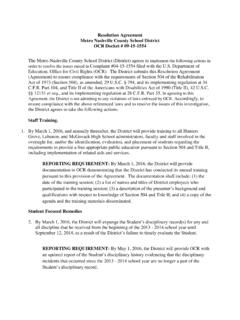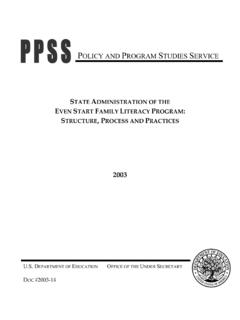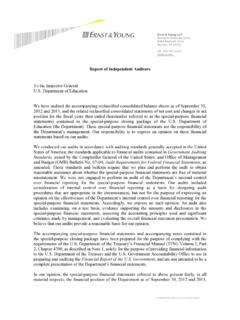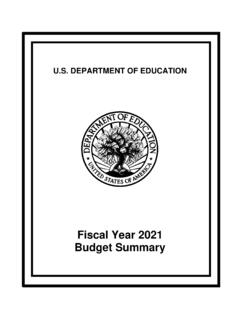Transcription of Non-Regulatory Guidance: English Learners and Title III of ...
1 Non-Regulatory Guidance: English Learners and Title III of the Elementary and Secondary Education Act (ESEA), as amended by the Every Student Succeeds Act (ESSA) September 23, 2016 Under the Congressional Review Act, Congress has passed, and the President has signed, a resolution of disapproval of the accountability and State plans final regulations that were published on November 29, 2016 (81 FR 86076). This guidance document is unaffected by that resolution and remains applicable. 2 Table of Contents Purpose .. 3 Introduction & Executive Summary .. 3 A-Fiscal Issues .. 5 General .. 5 Supplement-not-Supplant .. 6 State and District Administrative Costs .. 10 Subgrants to 11 Local Uses of Funds .. 13 B- English Language Proficiency Standards .. 15 C-Language Instruction Educational Programs .. 18 D-Educators of English Learners .. 22 E-Parent, Family, & Community Engagement .. 27 F- Early Learning .. 31 G-Immigrant Subgrant and serving Immigrant Students .. 34 H-Reporting and Data Collection.
2 37 I-Long-term English Learners .. 38 J-Former English Learners .. 39 K- English Learners with disabilities .. 40 Appendix A: Glossary .. 43 Appendix B: Resources by Topic Area .. 45 3 Purpose The Department of Education (Department) has determined that this guidance is significant guidance under the Office of Management and Budget s Final Bulletin for Agency Good Guidance Practices, 72 Fed. Reg. 3432 (Jan. 25, 2007). See Significant guidance is non-binding and does not create or impose new legal requirements. The Department is issuing this guidance to provide States and local educational agencies (LEAs) with information to assist them in meeting their obligations under Title III of the Elementary and Secondary Education Act of 1965 (ESEA), as amended by the Every Student Succeeds Act of 2015 (ESSA). This guidance also provides members of the public with information about their rights under this law and other relevant laws and regulations. Once this guidance is in effect (after the 2016-2017 school year) this guidance supersedes the 2008 Notice of Final Interpretations of Title III of the ESEA, as amended by the No Child Left Behind Act (NCLB), and the 2008 Guidance on the Supplement Not Supplant Provision of Title III of the ESEA.
3 If you are interested in commenting on this guidance, please email us your comment at or write to us at the following address: Department of Education Office of Elementary and Secondary Education 400 Maryland Avenue, Washington, 20202 For further information about the Department s guidance processes, please visit Introduction & Executive Summary In the last several decades, English Learners (ELs)1 have been among the fastest-growing populations in our Nation s schools. ELs comprise nearly 10 percent of the student population nationwide, and in many schools, local educational agencies (LEAs) and States, account for a n even higher percentage of the student ELs also comprise a highly diverse group of students who bring with them valuable cultural and linguistic assets, including their home languages. Yet despite these many assets, ELs face significant opportunity and academic achievement gaps compared to their non-EL peers. For example, in school year 2013-2014, the high school graduation rate for ELs was just percent, compared to percent for all With effective, research-based supports and access to excellent educators, ELs can 1 In the ESEA, as amended by the ESSA, the term, English learner replaces the term limited English proficient used in section 9101 of the ESEA, as amended by the No Child Left Behind Act (NCLB).
4 Please see the glossary section of this document for the definition of English learner. 2 Biennial Report to Congress on the Implementation of the Title III Grant Program. (October 2015) Available at: 3 National Center for Education Statistics (2014). Table 1. Public high school 4-year adjusted cohort graduation rate (ACGR), by race/ethnicity and selected demographics for the United States, the 50 States, and the District of 4 achieve English language proficiency and perform academically at the same high levels as their non-EL peers. The ESSA recognizes the unique needs of ELs, including by acknowledging the heterogeneity within the EL subgroup ( , recognizing separate groups of ELs such as English Learners with disabilities, recently arrived ELs, and long-term ELs). It moves several provisions relevant to ELs ( , accountability for performance on the English language proficiency assessment) from Title III, Part A of the ESEA as amended by the ESSA ( Title III) to Title I, Part A ( Title I) of the ESEA.
5 This guidance addresses Title III S tate formula grants, as well as limited portions of Title I pertaining to As States and LEAs begin to implement these changes to the ESEA, we encourage close collaboration among staff who administer Title I and Title III programs. This guidance addresses how Title III funds may be used to provide supplemental services that improve the English language proficiency and academic achievement of ELs, including through the provision of language instruction educational programs (LIEPs) and activities that increase the knowledge and skills of teachers who serve ELs. All services provided to ELs using Title III funds must supplement, and not supplant, the services that must be provided to ELs under Title VI of the Civil Rights Act of 1964 ( Title VI), the Equal Educational Opportunities Act of 1974 (EEOA), and other requirements, including those under State or local This guidance does not address the inclusion of ELs in academic content assessments in reading/language arts, mathematics, and science, English language proficiency assessments, accountability and school improvement under Title I, or the new Title III requirement that all States establish and implement standardized statewide entrance and exit procedures for ELs, as these topics will be addressed through rulemaking.
6 In general, the ESSA amendments to Title I and Title III take effect beginning on July 1, 2017. Thus, we recommend that States and LEAs begin planning for the implementation of these changes in fall or winter 2016. while this guidance largely focuses on changes due to the ESSA amendments, it also clarifies issues that have been addressed in previous guidance documents on ELs6 and Title III and addresses new topics that stakeholders recommended through Department Columbia: School year 2013 14. Retrieved from: 4 Title III includes two types of subgrants to LEAs: EL formula subgrants (See ESEA section 3111 and 3114(a)) and immigrant children and youth subgrants. (ESEA section 3114(d)). Title III also includes two discretionary grant programs, which are not addressed in this guidance.
7 (See ESEA Sections 3112 and 3131). 5 As recipients of Federal financial assistance under ESEA and other Department-funded grant programs, and as public entities, States and LEAs must also not discriminate against ELs in their educational programs based on race, color, national origin, sex, age, or disability. The Department s Office for Civil Rights (OCR) enforces Federal laws that prohibit discrimination on these bases. 6 Please also see the 2016 policy issued by the Department of Health and Human Services and Department of Education Policy Statement on Supporting the Development of Children who are Dual Language Learners in Early Childhood Programs which addresses bilingualism and nurturing the native and home languages of our youngest Learners . The statement and its recommendations can be found here: 5 outreach. In general, existing Departmental guidance7 on ELs and Title III is applicable through the 2016-17 school year. After that time, please refer to this guidance instead.
8 This guidance can assist States, LEAs, and schools to support ELs in achieving college and career readiness, participating in our schools and society, and maintaining their bilingualism as an asset. The Department hopes that this guidance will strengthen State and local efforts to improve educational outcomes for ELs and immigrant children and youth; connect States, LEAs, and schools with promising practices and helpful resources; and promote effective LIEPs for all ELs. Finally, recognizing the diversity of the EL population and the need for supports from cradle to career, this guidance touches upon distinct populations of ELs ( , English Learners with disabilities and long-term ELs) as well as supporting ELs in early learning programs. See the Appendices of this guidance for a glossary and resources. A-Fiscal Issues General A-1. Several provisions in the ESEA8 regarding ELs have moved from Title III to Title I. How does that affect a State s responsibility with respect to Title III funds, including monitoring an LEA s use of Title III funds?
9 Each State is still responsible for using Title III funds in a manner consistent with Federal law and guidelines, and retains all of its oversight responsibilities to ensure that its LEAs spend Title III subgrants in a manner consistent with Federal law and guidelines. See 34 CFR for general State administrative responsibilities. Under Section 3113(b)(3)(F) of the ESEA, each State is required to conduct Title III fiscal monitoring of its LEAs. See 2 CFR , for State obligations to conduct subrecipient monitoring. A new provision added by the ESSA permits the use of consolidated State administrative funds for fiscal support teams, which can be used for technical assistance to LEA subgrantees. (ESEA Section 8201(b)(2)(I)).9 State Educational Agency (SEA) Title I staff should work together with Title III staff to ensure a coordinated approach to serving ELs in the State. 7 This includes the 2008 Notice of Final Interpretations of Title III of the ESEA, as amended by the No Child Left Behind Act (NCLB), and the 2008 Guidance on the Supplement Not Supplant Provision of Title III of the ESEA, however, the nondiscriminatory requirements of Title VI and the EEOA, as discussed in the 2015 EL Dear Colleague Letter, will remain valid and are not affected by ESSA.
10 The 2015 Dear Colleague Letter about EL students and LEP parents jointly released by the Department of Education and the Department of Justice is available at 8 Throughout this document, unless otherwise indicated, citations to the ESEA refer to the ESEA, as amended by the ESSA. 9 Note that LEAs can also consolidate administrative funds (see ESEA section 8203), and they can use State and local funds to expand the reach of fiscal support teams without violating any non-supplanting requirement of any of the programs contributing funds. (ESEA section 8203(d)(2)). 6 Supplement-not-Supplant A-2. Does the amended supplement-not-supplant provision in the ESEA that applies to Title I also apply to Title III funds? No. The provision in Section 1118(b) of the ESEA setting forth requirements that Title I funds supplement and do not supplant non-Federal funds does not apply to Title III. Title III does, however, contain its own provision prohibiting supplanting of other Federal, State, and local funds, and that provision was not changed by the ESSA.
